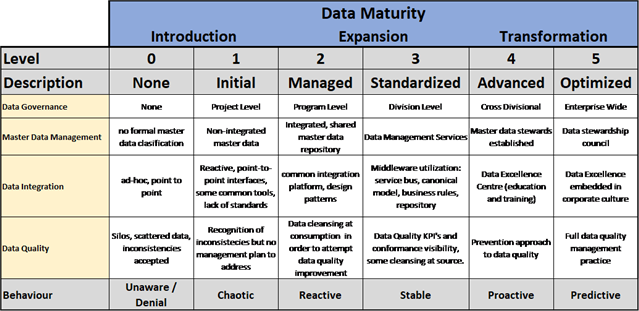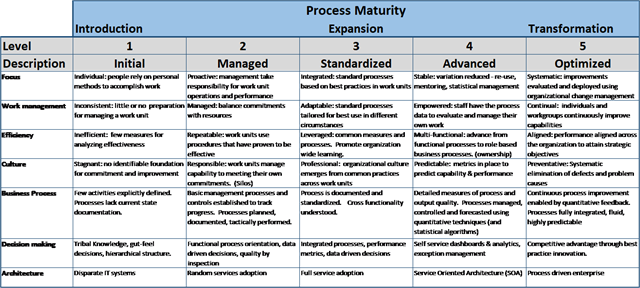On December 19th, 2017, Ron Huizenga presented a DATAVERSITY webinar on the importance of organizational maturity. His experience with manufacturing flows and Six Sigma standards provides him with a unique perspective, which is enhanced by his years as an enterprise architecture consultant. This blog captures some of the key points from the session.
The Data Maturity Model, based on the Capability Maturity Model developed by IBM’s Watts Humphrey, provides a guideline for understanding what level an organization has achieved across several categories, such as data quality and data governance. Businesses must transition incrementally between the levels – it’s not feasible to jump across levels in the scale, as each level builds on the one prior. And scores may be different for every row in the chart, such as achieving level 2 on data integration but still at level 1 on data quality. By honestly reviewing the internal status of each of these categories, a company can obtain a realistic view of its maturity level and evaluate what next steps are needed to make improvements.
The Process Maturity Scale has similar levels that address several characteristics of a company’s business process methodology. The corporate culture can have a significant impact on the level of maturity. Does the organization have data management and business processes defined as a priority? Is the flow of information within and between departments well documented and understood? Are resources properly assigned to projects and managed appropriately? If employees feel empowered to evaluate the data and improve the processes, then the organization can move up the maturity scale more rapidly.
Every business is an information factory, and everything it does is represented by data and processes. By driving improvements for both data maturity and process maturity, an organization can achieve organizational maturity with benefits including increased productivity, improved data quality, and a foundation for data governance for the enterprise architecture. With that approach, data governance can easily be developed and aligned with the enterprise architecture.
You can’t achieve organizational maturity with just data maturity or process maturity – you must have both. And you can’t just go out and buy data maturity or process maturity. Companies need to make organizational maturity a priority and enable their teams to implement and enforce the necessary processes to make it successful. It takes a top-down and bottom-up approach across the entire organization to drive maturity for both processes and data, and it is a long-term commitment, not a time-limited project. A company with a business-driven culture that understands the value of data will recognize increased productivity and profits.
ER/Studio Enterprise Team Edition can help a company create the right business processes and define the necessary data model infrastructure for building an enterprise architecture. With integrated data modeling, business process modeling, model and metadata repository, and collaborative business glossaries, ER/Studio offers a complete data architecture suite for companies serious about organizational maturity.
Watch the DATAVERSITY webinar replay to hear more on this topic. Learn more about ER/Studio and request a demo to see what it can do for you.

